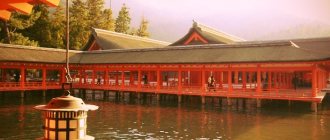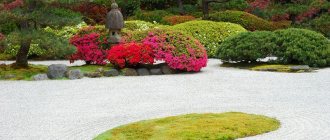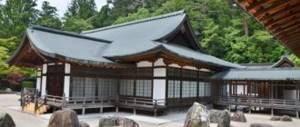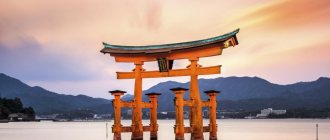Japanese rock garden - this is the garden of Ryoanji Temple in Kyoto!
Agree that Japan has not always been as famous and popular in our country as it is now. During the Soviet period, the person who spoke about the culture and customs of Japan was a famous television commentator, orientalist, a man who lived in Japan for 8 years - Vladimir Tsvetov. It was he who was the first person thanks to whom I learned that there is an amazing country of Japan and thanks to him I knew that there was a fifteenth stone of the Reanji Garden. Later I read his book of the same name. Even now, before my eyes, it’s already a little shabby, it was published in 1987. Having recently re-read it, I was a little “stressed” that it is very politicized and permeated with aversion to capitalism and seemingly eternal values, such as culture, are also viewed through the prism of negativity towards capitalism. But if you do not notice the unipolarity of judgments and see what Japanese life is, then you get valuable historical material.
The fifteenth stone of the Reanji Garden
Vladimir Tsvetov wrote about his visit to a rock garden in Japan:
“Rock Garden”, “Philosophical Garden”, “Ryoanji Garden”... Dozens of names for the main attraction of the Japanese city of Kyoto and, probably, its greatest value, and dozens of interpretations of the essence that the wise monk Soami put centuries ago into fifteen black, untreated and different by the size of the stones scattered on the white sand.
I said “fifteen stones” because that’s what the guidebook says. In fact, you only notice fourteen. The fifteenth stone is not before my eyes. It is blocked by neighbors. You take a step along the wooden gallery... - and again there are fourteen stones. The fifteenth one, the one that had been hiding until now, was now among them, and the other stone disappeared. Another step along the gallery, and the ingeniously planned chaos appears again in a different composition, consisting of the same fifteen stones, one of which is invisible.
And here I am in this famous rock garden!
I see with my own eyes what was once pictured before my eyes. Time has already passed and I cannot now describe the feeling that I experienced sitting on the veranda of the Ryoan-ji Temple. But I still remember that it was an inexplicable calm and detachment. There were also people sitting nearby, but everyone behaved very quietly, looking at the stones and gravel, everyone was thinking about their own things. After some time, the issues for which tourists come to the Japanese rock garden began to be discussed. How can you see this mysterious fifteenth stone and is it here?
Yes, there are fifteen stones in the garden. They are arranged in five groups, the largest group has 5 stones, two others have 3 stones each and two more groups of stones have two each.
First, we counted all the stones from the place where we were originally located, guessing behind which hill the invisible fifteenth stone of the Reanji garden was hidden. Then they stood up and walked along the entire wooden gallery, examining each group of stones from a new position.
Rock garden photo
To be honest, tourists come to the Japanese rock garden Ryoan-ji not to receive enlightenment and rise above the bustle to see all fifteen stones, and they choose a different time for meditation. You have to be at least a monk to sit in front of the stones early in the morning and dissolve, contemplating the picture.
This composition personifies the tiger. What do you see?
Therefore, our goal was to see and capture. How interesting are such gardens to European people? In order to get acquainted with the traditions of the school of Zen Buddhism, yes, they are interesting. But only a prepared person can get true pleasure.
A stone garden does not imply visual aesthetic pleasure, although this has its place. No wonder one of its names is the Philosophical Garden. This is a place where you can, contemplating a picture made of stones and gravel created by an unknown master, let go of the flow of thought, not control yourself, without words, without the desire to formulate a thought, just sit and watch, and the huge silent emptiness enveloping you creates images itself.
Buddhism is a religion of the East, but thanks to the Japanese philosopher and famous Buddhist scholar Daisetsu Suzuki, in the 60s of the 19th century, Buddhism began to quickly spread throughout the world. Daisetsu Suzuki offered the Western reader his concept of Zen Buddhism. In his works, he sought to bring Western and Eastern philosophy and psychology closer together. Against the backdrop of a boom in fascination with Eastern philosophy, Westerners became interested in primary sources.
It is believed that the Japanese rock garden of Ryoan-ji Temple gained fame and popularity after the visit of Queen Elizabeth II of England to Japan in 1975. Before her visit, the thousand-year-old lake located on the territory of the temple, with lotus flowers, framed along the banks by sakura and maple trees, was more popular than the rock garden. Elizabeth II's visit to the Temple of the Resting Dragon made the rock garden of Ryoan-ji Temple famous and popular.
In the image and likeness
Perhaps some of our readers will want to create something like a Japanese garden in their summer cottage. This matter may seem simple only at first glance. After all, none of the imaginary lines connecting two objects should be the same length as the other, these two imaginary lines should not be parallel, and two objects cannot be the same size.
The main thing to remember when planning your garden: the task is not to fill it with even the most wonderful plants and objects, but on the contrary, to “cut off” everything unnecessary, because a garden is a model of the world, and how you want your world to be , it's up to you to decide.
– Unfortunately, I didn’t have a chance to visit the rock garden. But my mother saw one in Japan and remembered it as a place of extraordinary beauty and harmony. The rock garden, according to my mother, does not give the impression of being artificially created by man, it seems like a corner of natural nature.
— Anna Kitayeva
Ryoanji Temple
Reanji is a small temple; visiting it will take no more than an hour. This is a Buddhist temple, its name means "temple of the resting/peaceful dragon." Drawings of a dragon decorate the main pavilion of the temple.
On the territory of today's temple complex, in the 11th century the first temple was built with a beautiful pond located nearby, which still exists. In 1450, Hosokawa Katsumoto bought the estate and built his residence there, which later became a temple for the school of Zen Buddhism. The emergence of the Reanji Buddhist Temple is associated with the name of the Buddhist monk Giten Gensho.
Ryoan-ji immediately became a famous temple of the Zen school from its founding. It is said that it was a great temple that had 21 structures on its premises. But during the civil war it was destroyed. Shortly after the war in 1499, the temple was restored and rebuilt by Katsumoto's son, Masayuki Hosokawa. Currently there are three buildings on the complex. The patrons of the temple were such famous statesmen and military figures of the time as Toyotomi Hideyoshi and Tokugawa Ieyasu (you can read about my visit to the temple complex in which Tokugawa Ieyasu, the powerful shogun of Japan, rests here)
The main building of the temple is a meditation hall (hojo), covered with tatami mats, sliding doors and a small Buddhist altar. It opens onto a veranda overlooking the rock garden.
On the temple grounds there are living quarters, kuri, 22 meters high, this is one of the tallest temples in Japan, the height of the temple indicates the high status of Ryoan-ji.
There is also a mausoleum in the temple for the deceased emperors of Japan. The mausoleum is known as the "Seven Imperial Tombs" and was long neglected and reconstructed during the Meiji period, after the overthrow of the shogunate and the restoration of imperial rule.
There is a beautiful lake and garden on the temple grounds. As mentioned above, these natural monuments have been preserved since the 11th century. The lake is very beautiful, as part of it is covered with lotuses, and in the spring, sakura blooms here unusually beautifully. In autumn, maple leaves delight park visitors with their bright red color. There is a path to the center of the lake to the island; those who wish can present gifts to the goddess Benzaiten. In addition to being the goddess of luck, love, wisdom and art, she is also the goddess of water. She is one of the favorite kami (deities) of the Japanese people in the lists of the seven gods of happiness of Japan.
And the Japanese are very fond of the pond because tangerine ducks live here and the temple is often called the temple of the tangerine duck / Oshidori-ike.
Helpful information
There are several ways to get to Reanji from Kyoto.
1. From Kyoto station, take bus 101 or 205 to the Golden Pavilion - Kinkakuji, and then walk 15 minutes or three times faster by bus. This way you can explore Reanji and the Golden Pavilion in one go.
Golden Pavilion
2. Take the train to the Reanji-miti stop, and then walk 5 minutes.
3. By taxi from Kyoto straight to the final point - this method is the most convenient, but at the same time the most expensive.
Reanji Rock Garden, history of creation
The history of the creation of the rock garden at Ryoanji Temple is not clear-cut. When Vladimir Tsvetov wrote his book, he wrote that the creator of the garden was considered Soami, a Japanese landscape artist, date of birth unknown, died in 1525. But over the centuries, in addition to Soami, many versions were considered and the authorship has not been established for certain.
The following persons are suggested as options: Hosokawa Katsumoto (statesman and military leader, 1442-1473) - the creator of the Ryoan-ji Temple, they also call the name of his son Hosokawa Masamoto and the date of creation of the garden - 1488, some authors believe that the garden was created much later and The date range is determined from the first half of the 16th century to 1680. There is a version that the garden was not created by monks, but was built by professional gardeners - kawaramono (translated as riverside workers, the lowest social class during the Kamakura and Muromachi periods).
Be that as it may, the rock garden was created and after so many centuries produces the same effect: dissolution in space, peace and tranquility. Or maybe, on the contrary, there is a sea of questions, what is a rock garden? A model of the world?, the basis of the universe?, an understanding that everything in the world is not as we see and that the truth is somewhere behind the 15th stone? Of course, these are just questions that have nothing to do with the school of Zen. Yes, there is a well-known interpretation of the idea of the garden that “only after achieving enlightenment can you see all 15 stones.” But there is another opinion that the stones located in the garden do not mean anything and were simply located as we see now. And everything else is games of imagination and fiction.
And yet, I am closer to the option that it is possible to comprehend the essence of the stone chaos created by the human mind only by clearing oneself of habitual stereotypes, bias and arrogant confidence that there are no questions to which the answer has not yet been found.
Japanese rock garden
Rock Garden in Japanese is karesansui 枯れ山水 and means “dry mountains and waters.”
The garden is a rectangle 30 meters from east to west and 10 meters from south to north. Five groups of stones are located on the surface at different distances. Ordinary uncut stones of various sizes. All the vegetation of the “garden” is moss framing the stones. The entire rectangle is covered with fine white gravel, which is carefully “combed” by the monks every day. The gravel symbolizes water, and the stones symbolize a mountain stream.
In the Ryoan Temple style, simplicity is seen in everything, so the compositions use simple solid colors, mainly white and black. It (the style) is characterized by the Japanese worldview of wabi-sabi: the idea that simplicity and imperfection represent true beauty. The temple premises and rock garden are proof of this.
Three sides of the rock garden are surrounded by a low clay wall, behind which trees grow.
You can only view the Reanji rock garden from the wooden gallery on the side of the monastery. And as you know, the 15th stone always remains invisible from this side. I read on one of the Japanese blogs that “there is only one place (a little west of the center) from which you can see all 15 stones.” I haven’t checked the reliability of the information, maybe this is true, but then what about the whole philosophy of the garden?
There are several theories about what this seemingly simple garden is:
- some people imagine mountains rising above the clouds.
- Others imagine islands in the sea.
- One fascinating theory states that each of the five breed groups has a special meaning:
- the easternmost group, starting from the main worship hall, represents the Buddha and means "perfection".
- The next group visible on the right is the whale and means “largest.”
- The central group is the tiger and means “the strongest.”
- The next group is turtle and means “longevity.”
- And the last group is the water bird and means “almighty” because such birds can live both on land and on water.
However, it is up to you to decide what the stones in Ryoanji represent. If possible, be sure to visit the garden on a weekday morning so that you can enjoy contemplating the rock garden.
this composition supposedly represents Buddha
And this is a tiger, a turtle and a bird.
Nanzenji
Nanzenji is a complex of several temples, a major center of Buddhism. Here we first encountered a rock garden. But this is not a completely dry garden; here stones coexist with trees. If you look closely, in the outlines of the stones you can guess a group of tigers with cubs swimming across the river.
The paintings on the sliding partitions are very good. These are copies from 2002, but very good, and they repeat the paintings of the imperial chambers.
Another attraction of Nanzenji is the Western-style aqueduct, built in the late 19th century.
Tsukubai
Then, walking around the temple along a wooden path (by the way, we left our shoes before entering), the eye switches from the monotonous picture of gravel and stones to the lush vegetation of the garden. And the most interesting thing on this side is Tsukubai, a unique stone washbasin donated by Toyotomi Hideyoshi. There are other options for the origin of tsukubai - it was donated to the temple by the famous Tokugawa Mitsukuni (1628-1700), the head of the samurai Mito clan, a descendant of the shogun Tokugawa Ieyasu.
Tsukubai is a small stone pool in which hands are washed before the tea ceremony. Its very name 蹲い translates as bending, squatting.
Tsukubai is an important part of the temple; four characters are carved on it, which express the essence of Zen teachings, 吾, 唯, 足, 知. Each of the characters itself is incomplete without the sign 口, which is a component of each of the kanji listed. The square-shaped central hole of the tsukubaya provides this mark. The inscription on the tsukubaya reads “I have learned to be content” or, based on Buddhist teachings, can be translated as “Everyone already has everything they need.”
A person who has learned to be content with what he has is spiritually rich and, on the contrary, one who does not learn to be content is spiritually poor despite material wealth. What is written on tsukubaya makes you think about life and your goals. Do you need to continue to strive to achieve your plans, no matter what? Or do we need to learn a different perception of the world and our place in it? The phrase inscribed on the walls of tsukubaya makes you think and look deep into yourself.
Zen is a religion in which one says, “I only know what is necessary.”
And on this side of the garden, visitors sat contemplating their surroundings and absorbing the energy of the temple. Although no, they probably worship another god - the iPhone.
Sometimes you think, why am I not a Buddhist monk? Why do we constantly rush forward without realizing what is happening. We don’t appreciate (or rather, we don’t have time or don’t think about) what is happening to us at the moment. Perhaps if you stop more often, thinking about “that I am happy with what I have,” life will not be so fleeting?
Having stayed in the Ryoan-ji Temple for no more than an hour, immersed in the philosophy of Zen Buddhism, and experienced the magnetism of the Ryoan-ji Rock Garden and Tsukubaya, we moved on, towards new adventures.
Peculiarities
Only at first glance it seems that the stone blocks are arranged randomly and are in chaos. In fact, if you delve deeper into the art of sekitei, you can understand the complexity of such a minimalist composition, which requires compliance with special rules.
The main rule of composition is that from whatever angle you look at it, you can see an equal number of stones. The northern part is called the best for observation - even being at its zenith, the sun does not blind and does not interfere with correct perception.
Let's name the main features of the sekitei device:
- The asymmetrical arrangement of the stones is observed - they should not be parallel to each other, but should have different sizes, shapes, horizontal or vertical orientation.
- Loose and cluttered parts balance each other.
- It is customary to lay stones at the intersection of heptagon lines to achieve greatest harmony.
- The circles carved around the stones symbolize the uneven surface of the water.
- The largest stones represent Mount Meru, sacred to Buddhists, from where the universe originates, or the Teacher Shakyamuni himself.





